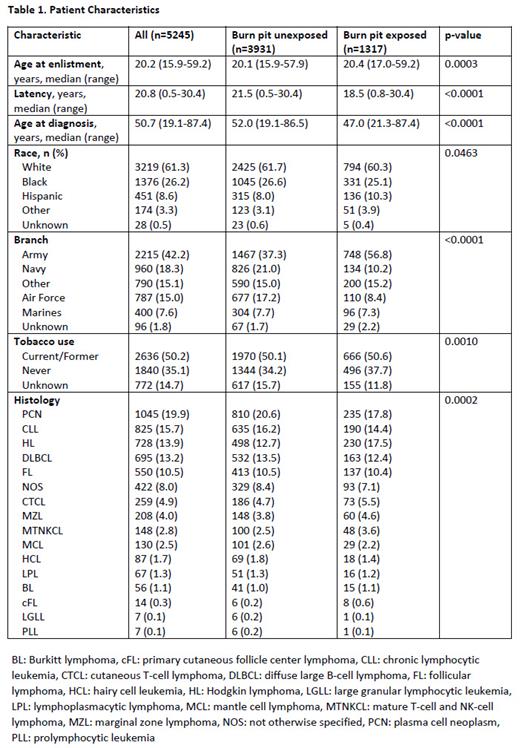Introduction
Military personnel were deployed to the Middle East for the Persian Gulf War (8/1990-7/1991), Operation Enduring Freedom (10/2001-12/2014), and Operation Iraqi Freedom (3/2003-11/2011), where they were exposed to environmental hazards including geological dust chemical smoke from burn pits, and heavy metal condensates 1. Burn pits are open-air fires that are used to dispose of food, human waste, plastic bottles, and electronic equipment during the conflicts in the Middle East and release high levels of dioxins, furans, particulate matter, polycyclic aromatic hydrocarbons, and volatile organic compounds, all well established as known human carcinogens 1. Outcomes in veterans diagnosed with lymphoid malignancies with and without burn pit exposure are unknown and warrant further study.
Methods
This is a retrospective case-case analysis of veterans diagnosed with mature lymphoid malignancies identified from the VA Cancer Registry 2. Descriptive statistics were used to compare cases with and without burn pit risk. Burn pit risk was defined as exposure to Iraq or Afghanistan from the VA Cancer Registry, combat in the Middle East from the VA disability database, or exposure to known chemical locations at Al Jubayl in Saudi Arabia or Khamisiyah in Iraq from USVETS. The Persian Gulf War began 8/2/90 and was considered the presumptive start date of burn pit risk, which was calculated from time at risk until exit from the military. Latency was defined as the time from exposure to the development of a lymphoid malignancy. Cases were excluded if veterans exited the military before 8/2/90 or entered after 12/31/14, latency of exposure to the diagnosis of lymphoid malignancy <6 months, or the burn pit risk was <1 month from 8/2/90 to exit from military. Overall survival (OS) was calculated by time from diagnosis to date of death or last contact, and disease specific survival (DSS) was calculated from time from diagnosis to date of death from a hematologic malignancy or last contact. OS and DSS by histologic subtype were compared by the Kaplan Meier method. Dates and causes of death were determined by the National Death Index, which provided data up to 12/31/20 (data cut off date) 3.
Results
Patient characteristics are summarized in Table 1. Veterans exposed to burn pits were diagnosed with a lymphoid malignancy at a younger age compared to the unexposed group (47 vs 52 years, p<0.0001). There were differences in racial distribution between the two groups (p=0.0463). More veterans who were exposed to burn pits enlisted in the army (56.8% vs 37.3%) and fewer in the navy (10.2% vs 21.0%) compared to the unexposed group (p<0.0001). Exposed patients had a higher frequency of Hodgkin lymphoma (17.5% vs 12.7%) and lower frequency of plasma cell neoplasms (17.8% vs 20.6%) and chronic lymphocytic leukemia (14.4% vs 16.2%) compared to those who were unexposed (p=0.0002). The difference in age between the exposed and unexposed group may contribute to the different frequencies of these subtypes. By histologic subtypes, the median OS and DSS were not significantly different between the two groups. More patients in the unexposed group died when compared to the exposed group (25.2% vs 18.9%, p<0.0001), but the causes of death did not differ.
Conclusion
Veterans exposed to burn pits may be diagnosed with a lymphoid malignancy at a younger age compared to unexposed veterans, but there is no difference in median OS or DSS by histologic subtype. More veterans who were unexposed to burn pits died but there were no differences in the causes of death between the two groups. This may be explained by the exposed group being younger and the “healthy soldier effect”. We are continuing to examine the effect of burn pits on the development and outcomes of lymphoid malignancies in more detail.
Citations
1 Institute of Medicine. Long-Term Health Consequences of Exposure to Burn Pits in Iraq and Afghanistan. Washington, DC: The National Academies Press; 2011.
2 US Department of Veteran Affairs. VA Informatics and Computing Infrastructure (VINCI), VA ORD 22-D4V, U.S. Department of Veterans Affairs. 2008. Retrieved August 1, 2022, from https://vincicentral.vinci.med.va.gov.
3 Veterans Health Administration Center of Excellence for Suicide Prevention. Joint Department of Veterans Affairs and Department of Defense Mortality Data Repository. 2022. Data compiled from the National Death Index. Extract December 6, 2022.
Disclosures
No relevant conflicts of interest to declare.


This feature is available to Subscribers Only
Sign In or Create an Account Close Modal